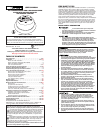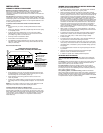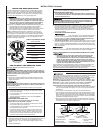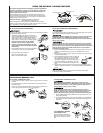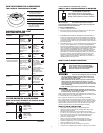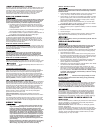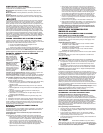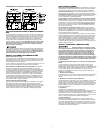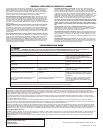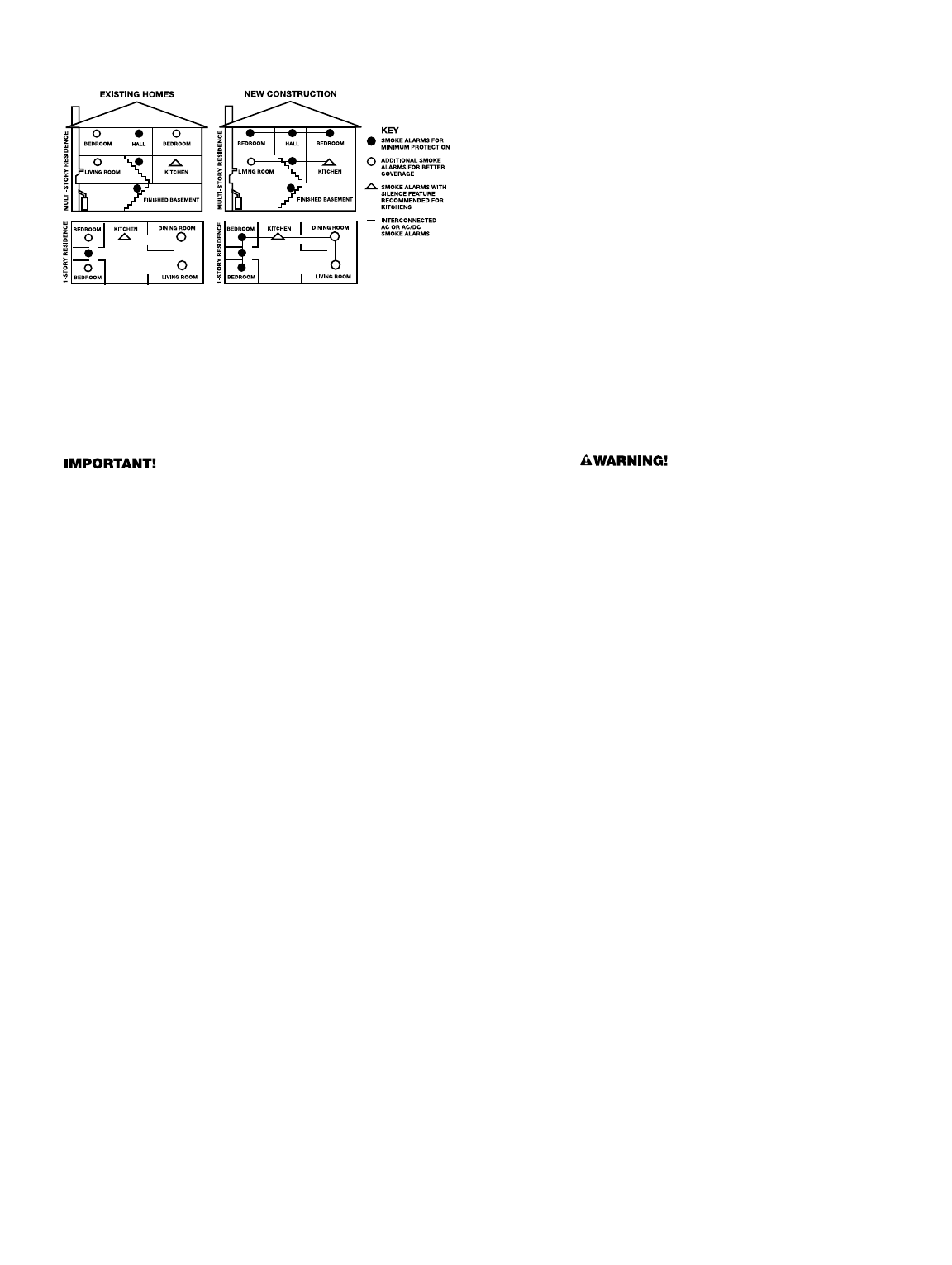
8
RECOMMENDED LOCATIONS FOR SMOKE ALARMS, Continued
INSTALLING SMOKE ALARMS IN MOBILE HOMES &
RVS
For minimum security install one Smoke Alarm as close to each sleeping
area as possible. For more security, put one unit in each room. Many older
mobile homes (especially those built before 1978) have little or no insula-
tion. If your mobile home is not well insulated, or if you are unsure of the
amount of insulation, it is important to install units on inside walls only.
Smoke Alarms should be installed where temperatures normally remain
between 40˚F (4˚C) and 100˚F (38˚C).
WARNING: Test units used in RVs
after the vehicle has been in storage, before every trip, and once a
week while in use. Failure to test units used in RVs as described
may remove your protection.
This equipment should be installed in accordance with NFPA (National Fire
Protection Association) 72 and
101. National Fire Protection Association,
One Batterymarch Park, Quincy, MA 02269-9101. Additional local build-
ing and regulatory codes may apply in your area. Always check com-
pliance requirements before beginning any installation.
AGENCY PLACEMENT RECOMMENDATIONS
NFPA 72 (National Fire Code)
Smoke Alarms shall be installed in each separate sleeping room, outside
each sleeping area in the immediate vicinity of the bedrooms and on each
additional story of the family living unit, including basements and exclud-
ing crawl spaces and unfinished attics.
In new construction, Alarms shall be so arranged that operation of any one
Alarm shall cause the operation of all Alarms within the dwelling.
Smoke Detection-Are More Smoke Alarms Desirable?
The required
number of Smoke Alarms might not provide reliable early warning
protection for those areas separated by a door from the areas protected
by the required Smoke Alarms. For this reason, it is recommended that
the householder consider the use of additional Smoke Alarms for those
areas for increased protection. The additional areas include the base-
ment, bedrooms, dining room, furnace room, utility room, and hallways
not protected by the required Smoke Alarms. The installation of Smoke
Alarms in kitchens, attics (finished or unfinished), or garages is not nor-
mally recommended, as these locations occasionally experience condi-
tions that can result in improper operation.
California State Fire Marshal (CSFM)
Early warning detection is best achieved by the installation of fire detec-
tion equipment in all rooms and areas of the household as follows: A
Smoke Alarm installed in each separate sleeping area (in the vicinity, but
outside bedrooms), and Heat or Smoke Alarms in the living rooms, dining
rooms, bedrooms, kitchens, hallways, finished attics, furnace rooms,
closets, utility and storage rooms, basements, and attached garages.
ABOUT SMOKE ALARMS
Battery (DC) operated Smoke Alarms: Provide protection even when
electricity fails, provided the batteries are fresh and correctly installed.
Units are easy to install, and do not require professional installation.
AC powered Smoke Alarms: Can be interconnected so if one unit
senses smoke, all units alarm. They do not operate if electricity fails.
AC with battery (DC) back-up: will operate if electricity fails, provided
the batteries are fresh and correctly installed. AC and AC/DC units
must be installed by a qualified electrician.
Smoke Alarms for Solar or Wind Energy users and battery backup
power systems: AC powered Smoke Alarms should only be operated
with true or pure sine wave inverters. Operating this Smoke Alarm with
most battery-powered UPS (uninterruptible power supply) products or
square wave or “quasi sine wave” inverters will damage the Alarm. If
you are not sure about your inverter or UPS type, please consult with
the manufacturer to verify.
Smoke Alarms for the hearing impaired: Special purpose Smoke
Alarms should be installed for the hearing impaired. They include a visu-
al alarm and an audible alarm horn, and meet the requirements of the
Americans With Disabilities Act. These units can be interconnected so if
one unit senses smoke, all units alarm.
All these Smoke Alarms are designed to provide early warning of fires if
located, installed and cared for as described in the user’s manual, and if
smoke reaches the Alarm. If you are unsure which type of unit to install,
refer to NFPA (National Fire Protection Association) 72 (National Fire
Alarm Code) and NFPA 101 (Life Safety Code). National Fire Protection
Association, One Batterymarch Park, Quincy, MA 02269-9101.
Local
building codes may also require specific units in new construction or in
different areas of the home.
SPECIAL COMPLIANCE CONSIDERATIONS
This unit alone is not a suitable substitute for complete fire detec-
tion systems in places housing many people—like apartment build-
ings, condominiums, hotels, motels, dormitories, hospitals, long-
term health care facilities, nursing homes, day care facilities, or
group homes of any kind—even if they were once single-family
homes. It is not a suitable substitute for complete fire detection
systems in warehouses, industrial facilities, commercial buildings,
and special-purpose non-residential buildings which require special
fire detection and alarm systems. Depending on the building codes
in your area, this unit may be used to provide additional protection
in these facilities.
The following information applies to all four types of buildings listed
below:
In new construction, most building codes require the use of AC or
AC/DC powered Smoke Alarms only. AC, AC/DC, or DC powered
Smoke Alarms can be used in existing construction as specified by local
building codes. Refer to NFPA 72 (National Fire Alarm Code) and NFPA
101 (Life Safety Code), local building codes, or consult your Fire
Department for detailed fire protection requirements in buildings not
defined as “households.”
1. Single-Family Residence:
Single family home, townhouse. It is recommended this unit be installed
on every level of the home, in every bedroom, and in each bedroom
hallway.
2. Multi-Family or Mixed Occupant Residence:
Apartment building, condominium. This unit is suitable for use in individ-
ual apartments or condos, provided a primary fire detection system
already exists to meet fire detection requirements in common areas like
lobbies, hallways, or porches. Using this unit in common areas may not
provide sufficient warning to all residents or meet local fire protection
ordinances/regulations.
3. Institutions:
Hospitals, day care facilities, long-term health care
suitable for use in individual patient sleeping/resident rooms, provided a
primary fire detection system already exists to meet fire detection
requirements in common areas like lobbies, hallways, or porches. Using
this unit in common areas may not provide sufficient warning to all resi-
dents or meet local fire protection ordinances/regulations.
4. Hotels and Motels:
Also boarding houses and dormitories. This unit is suitable for use
inside individual sleeping/resident rooms, provided a primary fire detec-
tion system already exists to meet fire detection requirements in com-
mon areas like lobbies, hallways, or porches. Using this unit in common
areas may not provide sufficient warning to all residents or meet local
fire protection ordinances/regulations.



